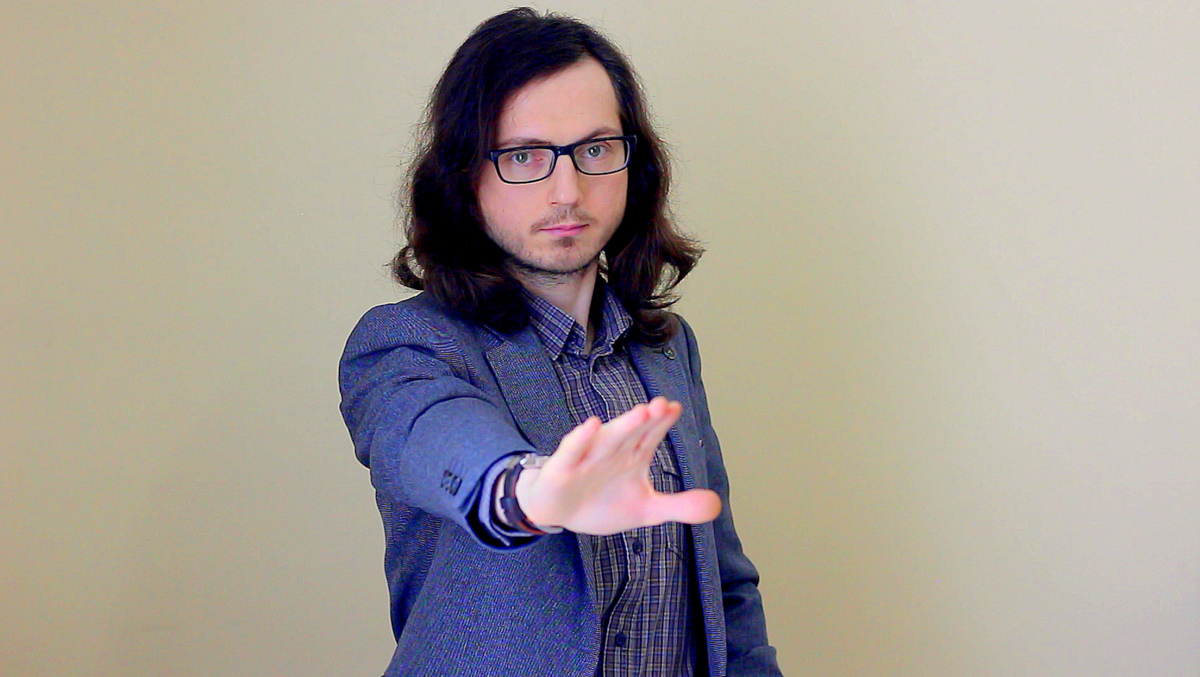
Serkan Aktaş is an award-winning filmmaker, screenwriter, and director known for his compelling storytelling and meticulous approach to filmmaking. With a profound passion for cinematic expression, Serkan has made a name for himself through his ability to craft visually striking narratives that resonate deeply with audiences. Drawing inspiration from legendary filmmakers like Alfred Hitchcock, Sergio Leone, and Steven Spielberg whose work blend’s meticulous detail, psychological depth with visual artistry.
His journey into filmmaking began at Beykent University, where he earned his master’s degree and crafted his thesis film, Aynanın Gizemi/Mirrorty, which garnered international acclaim. Since then, Serkan has proven himself as one of Turkey’s most respected filmmakers, combining a deep understanding of cinema theory with innovative storytelling techniques. His films often explore complex themes with a keen focus on character development, atmosphere, and emotional resonance.
Serkan believes that storytelling is the heart of cinema, and he approaches each project with the mantra, “Read every day, watch every day, write every day, and then make your movie.” His commitment to the craft is evident in his films, where the story always takes precedence, followed by an immersive visual experience that enhances the emotional impact.
The Official Trailer for Mirrority Directed by Serkan Aktaş
In his directing process, Serkan emphasizes collaboration with actors, striving to build personal, trusting relationships well before production begins. He believes that strong performances come from a deep, personal connection between the director and the actors, where they feel understood and trusted.
Currently, Serkan is working on several exciting projects, including Kanlısırt – The Blood Ridge, a feature film set during the intense Battle of Gallipoli, as well as a sci-fi robot story. As Turkey’s most awarded filmmaker, his ambitions are to create films that not only reach millions but also leave an indelible mark on the global cinema landscape. We sat down for an interview with Serkan Aktaş, the visionary behind Mirrorty, to explore his filmmaking journey and distinctive approach to storytelling
indieactivity: Now that “Mirrorty” is complete, what are you feelings about the entire project?
Serkan Aktaş: (SA): Mirrorty holds a special place for me as it not only represents my creative and intellectual journey, but it was also the culmination of my academic pursuits in film. Made in 2017 as part of my Master of Art degree at Beykent University, it gave me the unique opportunity to test and apply the theoretical frameworks I had studied, particularly the three-act dramatic structure and Jung’s archetypes.
On a deeper level, it’s a reflection of my desire to create stories that resonate with both psychological and philosophical elements, pushing the boundaries of what’s seen and felt on screen. My consultant and academic advisor, Asst. Prof. Dr. Ekin Gündüz Özdemirci, played a crucial role in shaping the film’s intellectual and creative direction, providing invaluable support and guidance throughout the entire process. His insights were instrumental in helping me realize the full potential of the project.
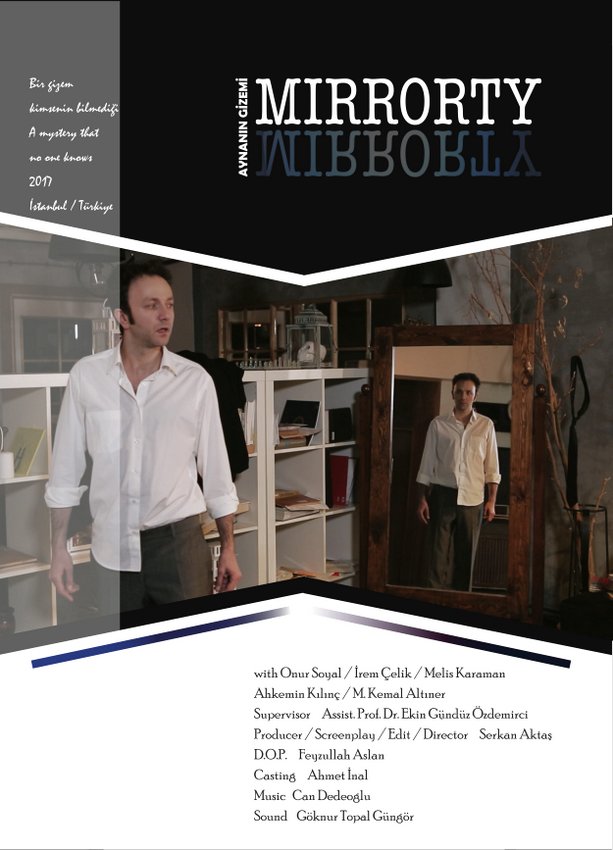
The project itself was a complex and challenging process, particularly because of the intricate mirror scenes, which required precise planning and rehearsal. The suspenseful nature of the film, leading to a cathartic climax, was designed to engage the viewer’s emotions and intellectual curiosity. I’ve always believed that cinema should stir something deep within the viewer, and Mirrorty was crafted with that very purpose in mind.
One of the most significant aspects of this journey for me was the production process. As a filmmaker, collaborating with professionals across different fields gave me invaluable insights into the practical side of filmmaking. I was also fortunate enough to play the role of a producer, which deepened my understanding of the production phase. The journey from concept to completion was not only about creating a film but also about learning and evolving as an artist.
As I reflect on the project, I’m filled with a sense of gratitude for the entire experience. It’s not just about the film itself, but about the lessons it taught me—about perseverance, teamwork, and the art of filmmaking. The final result, with its closed ending and psychological intensity, is a testament to the fact that every film, no matter how challenging, can ultimately provide us with something meaningful—whether it’s intellectual, emotional, or both. That’s what cinema is all about for me: creating stories that people can watch repeatedly, as they hold something new each time, sparking curiosity, wonder, and reflection.
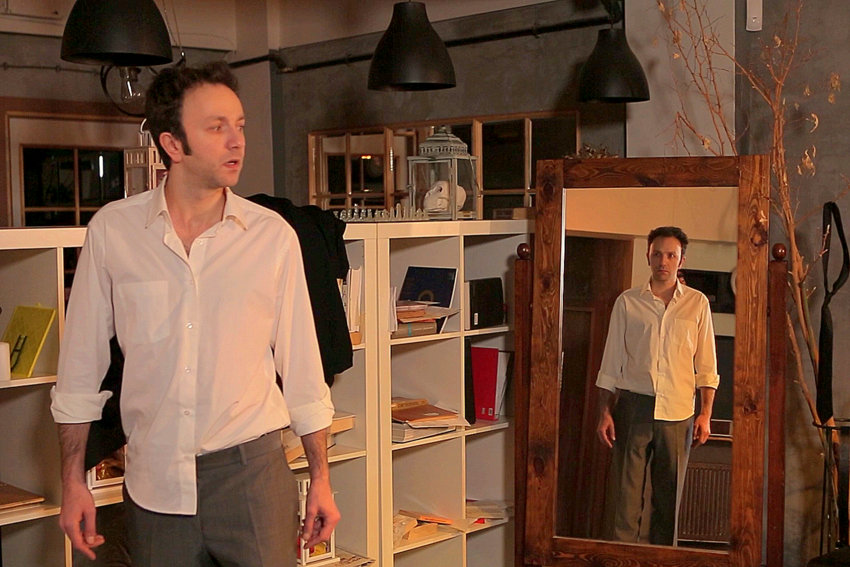
Casting is one of those steps in a films production you have to get right. How did you get through it?
Serkan Aktaş: (SA): Casting is, without a doubt, one of the most crucial elements in filmmaking, and it’s something I learned the hard way. When I first attempted Mirrorty, I cast amateur actors, most of whom were my friends. It was their first experience in film, and unfortunately, the result wasn’t what I had hoped for. The cast didn’t align with the vision I had for the characters, and the film didn’t achieve the emotional depth I wanted. It was a failure, and I had to face that as a filmmaker.
However, this failure became a pivotal turning point for me. I met Ahmet İnal, a highly respected casting director and the head of Callback İstanbul Casting Agency. After explaining the situation to Ahmet, he empathized with me and understood my struggles. He then helped me navigate this challenge by arranging a new casting process. We carefully selected the key cast members from Ahmet’s extensive catalog of talented actors, making sure each choice was the right fit for the film.
Once the new cast was in place, we rehearsed together extensively before shooting. The second attempt was night and day compared to the first. The actors brought the characters to life in a way that resonated with the story and with the audience. We created a powerful dynamic on set, and as a result, the film received widespread recognition. The movie not only earned several prestigious awards, but also garnered Best Actor awards at various film festivals around the world.
This experience taught me a valuable lesson: casting is everything. The right cast can elevate a film, while the wrong one can hinder its potential. I’m grateful for the journey, and for how the second casting process turned out—because it truly made all the difference.
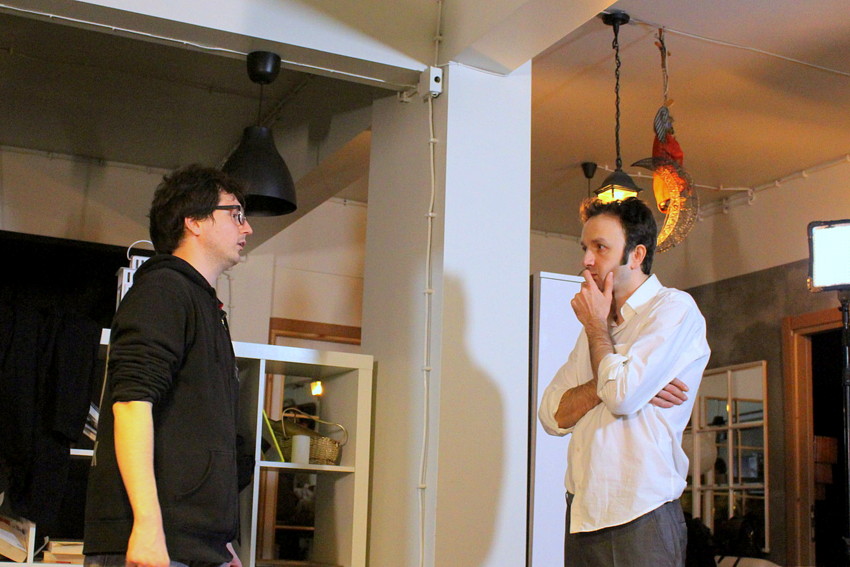
What went into the pre-production process for “Mirrorty”?
Serkan Aktaş: (SA): The pre-production process for Mirrorty was an essential phase, especially considering the complexity of the film and the challenges I had faced during the first attempt. After the failure of the initial try, I knew I needed to approach pre-production with a lot more precision and planning.
The first step was changing the cast. After the initial cast didn’t meet the vision I had for the film, I worked with casting director Ahmet İnal to select the right actors from his catalog. Once the new cast was in place, we focused on the next steps of the process. The psychological thriller genre of Mirrorty called for environments that could capture the right atmosphere—something that felt isolated, eerie, and suited to the unfolding mystery. Once the locations were chosen, I began organizing the technical team, the post-production crew, and the music studio. Coordinating schedules and ensuring everyone was available at the right time was key to the success of the production.
Due to the nature of the film, we had to think ahead, especially about the challenging mirror scenes. Knowing how complex these shots would be, I arranged a photoshoot work before the actual shooting days. This allowed the cast to familiarize themselves with the tricky scenes and helped us plan accordingly. The photoshoot was done to work out the details of the mirror shots, as these sequences were pivotal to the story.
Additionally, I wanted to make sure that every detail was in place, so I visited the filming locations multiple times before the shoot, revisiting each space and confirming the final decisions for the setting. Rehearsals with the cast took place before we officially began shooting, allowing us to adjust costumes, props, and make sure everyone was comfortable with their roles.
To avoid any disruptions during the filming, I made sure to gather all necessary permissions and deed of consents from the actors in advance. The pre-production period was essential in ensuring that the second attempt at Mirrorty would go smoothly. We didn’t want to miss any details, especially given the complexity of the film’s structure and its psychological nature.
Looking back, the pre-production process was an invaluable learning experience. The meticulous planning and early rehearsals set the stage for the success of the film, and I was grateful for the chance to apply all my learnings and adjustments from the first attempt to create something truly compelling.
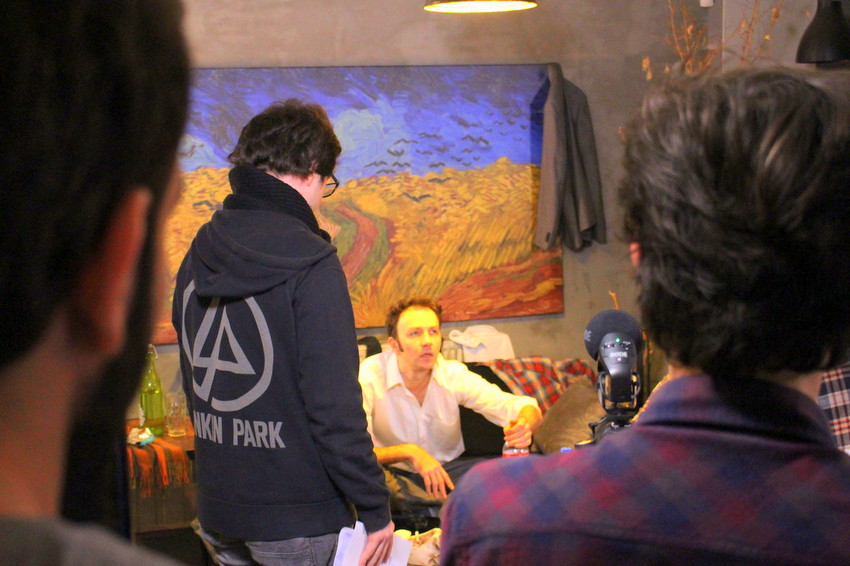
Without giving anything away, tell us a little bit about the script, how did you come up with the idea?
Serkan Aktaş: (SA): The idea for Mirrorty emerged from my academic studies and a deep fascination with the psychological and philosophical aspects of cinema. While working on my thesis, I was inspired by the study of ‘Identification in Cinema,’ especially my analysis of Alfred Hitchcock’s Vertigo. This led me to explore the theories of Lacan and Metz on the mirror stage and the concept of identification. These theories, particularly the idea of how mirrors reflect and distort reality, became central to the script.
In my research, I revisited films that used mirrors as a symbolic element, such as Tarkovsky’s Zerkalo (Mirror), Mirrors (2008), and the psychological short film Reflections (2014). These films, along with my academic findings, shaped my desire to create a story that used mirrors within the genres of psychological thriller and science fiction.
The pivotal moment came one day while I was talking with a friend who specialized in mathematics. We had an in-depth discussion about how a two-dimensional surface, like a mirror, could appear to have three-dimensional depth. In that conversation, I had a breakthrough idea for the film: ‘Mysteriously, mirrors hold some people captive.’ This concept struck me as a compelling way to explore themes of identity, perception, and the human mind.
From there, I knew I wanted to create a classic single-hero narrative. The structure of the film followed the principles of the three-act dramatic structure and the hero’s journey. The protagonist’s journey was also deeply influenced by Carl Gustav Jung’s theory of archetypes, where the hero’s internal struggles mirror the external challenges they face. What emerged was a film that weaves these complex ideas into a psychological thriller, centered around a character whose reality becomes increasingly warped by their interaction with mirrors.
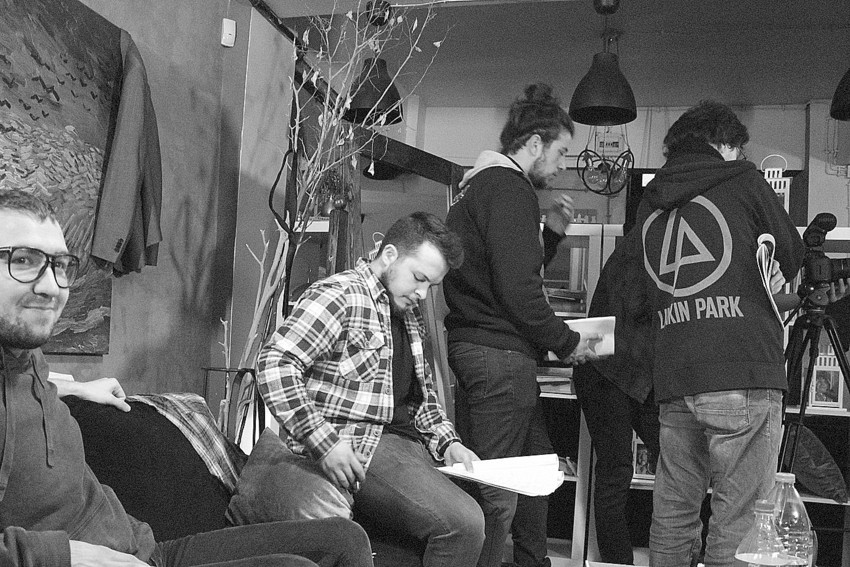
Who is “Mirrorty” for? Who do you think would enjoy it the most?
Serkan Aktaş: (SA): Mirrorty is a deeply personal project for me, as it began as my Master’s Thesis in Film and Television, Master of Art at Beykent University. In many ways, the film was for me—an exploration of the ideas and themes I’ve spent years studying. But at the same time, it’s for the audience. I want people to experience the same joy and wonder that cinema brings me. This film is a way of sharing that passion and engaging with those who, like me, are fascinated by the complex relationship between identity, technology, and reality.
The film was heavily inspired by psychoanalytic theories, particularly Lacan’s mirror stage. Through Mirrorty, I wanted to explore how modern technology, especially devices like smartphones and computers, has transformed our sense of self. The protagonist’s journey mirrors the way technology alienates us from the real world, turning our reflection into something distorted and isolating. The black mirrors of our digital devices became a visual metaphor for this, symbolizing how the lines between reality and the virtual world blur.
Ultimately, Mirrorty is for anyone who is curious about the deeper questions of identity, perception, and the impact of technology on our lives. It’s for those who enjoy thought-provoking cinema and are open to the challenges of interpreting complex ideas. With my intellectual perspective and filmmaker identity, I strive to find solutions to the world’s unsolved real-world problems or contribute to those solutions through making movies. That’s what I do—using the medium of film to ask important questions and invite the audience to reflect on their own experiences with these universal issues.
How long did it take to shoot the entire film?
Serkan Aktaş: (SA): The shooting of Mirrorty was completed within the planned time frame, which was 2 days. Despite the complexity of the film, especially with the challenging mirror scenes, we were able to stay on schedule. The tight schedule was a testament to the careful pre-production planning, photoshoot work and rehearsals, which helped ensure that everything went smoothly during the actual shoot.
How did you work with actors to get the best performances? Give us a typical on set direction at production?
Serkan Aktaş: (SA): For me, building a relationship of trust and mutual respect with my actors is key to getting the best performances. I see directing actors as a collaboration, not just giving orders or instructions. Just like how Quentin Tarantino befriended his key cast members before filming Pulp Fiction, I believe in creating an atmosphere where the actors feel comfortable and supported. This personal connection helps to bring out the authenticity and depth in their performances.
This technique is particularly important when working with younger or less experienced actors. Directing kids can be challenging because they may not always understand the technical demands of the scene or might feel nervous. So, I take time to develop a rapport with them before we begin shooting. I try to create a space where they feel safe and free to experiment, just like Sir Joshua Reynolds did when working with Miss Bowles.
Reynolds’ two weeks of playing and telling stories to build trust is an excellent example. By gaining her confidence, he was able to capture the true essence of her spirit in the portrait. In a similar way, as a director, I make sure the actors feel seen, heard, and relaxed before we dive into a scene. When they feel this trust, their performances naturally become more genuine and impactful.
In the end, I believe that strong performances come from a deep, personal connection between the director and the actors—where they feel understood and trusted. The relationship must start 2, 3, or even 4 weeks before the set. This allows for the actors to feel at ease, truly connect with the material, and trust me as a director, which ultimately results in the most genuine and impactful performances.
“Mirrorty” had talent behind the scenes designers, composers, etc. How did you handle creative differences?
Serkan Aktaş: (SA): “Mirrorty” had several talented individuals working behind the scenes, including designers, composers, and other creatives. Managing creative differences is always a part of filmmaking, especially in a project like this, where the stakes were high, and the process was demanding.
For me, the key was always ensuring that everyone involved understood the core idea of the film and its vision. With “Mirrorty,” I had a clear image of what I wanted to create, and it was important that the collaborators—whether they were visual artists, sound designers, or post-production specialists—were on the same page.
One of the major challenges we faced was during the visual and sound design phase. This was especially the case with the visual effects and color grading, which played a pivotal role in enhancing the psychological thriller atmosphere. These processes were critical for us to convey the tension and unease of the film.
In the second try of “Mirrorty,” after the previous failure, I had the opportunity to work with professionals who shared my passion for the project. I focused on open communication and respecting the input of each individual, which I believe helped us navigate creative differences smoothly. For example, when working with visual designers, we made sure the aesthetics fit the narrative’s psychological intensity, and when collaborating with sound designers, we ensured the sounds amplified the film’s suspense.
The project’s success, despite the budget constraints, was a result of not just finding solutions to creative conflicts but also embracing each creative’s contribution while aligning everything with the film’s core vision. The collaborative nature of filmmaking is a process where challenges are met with compromise, and creativity is always nurtured through dialogue and shared goals.
What techniques do you use to ensure a film is cohesive and flows well throughout the story?
Serkan Aktaş: (SA): For me, the most essential element in ensuring a cohesive and smooth-flowing film is the story. Dramatic structure is everything, and I always start there. I spend a lot of time refining the story before I even begin the script. I believe that every option, parameter, and detail matters because the devil hides in the details. A solid foundation is key to making sure that every aspect of the story works in harmony as the film progresses.
I always say, “Read every day, watch every day, write every day, and then make your movie.” This quote embodies my creative process. The more input I expose myself to, the better my output becomes. By constantly engaging with stories and refining my own, I learn to think critically about structure and flow.
Once I have a strong story that fits within the dramatic structure, I move on to the script. But here again, attention to detail is crucial. I ensure that the narrative unfolds naturally, with each scene building upon the last. The details—whether it’s the character’s arc, the dialogue, or the pacing—are critical to making sure the story flows seamlessly from beginning to end.
Only after the script is solid do I begin considering visuals. I always prioritize the story. The visuals must serve the narrative, enhancing the themes and emotional beats. Once the story is in place, everything else—whether it’s cinematography, lighting, or editing—fits into the larger picture, making the film feel cohesive and complete.
What shots and camera angles do you prefer for particular scenes and why?
Serkan Aktaş: (SA): For me, camera angles and shots are not just technical choices; they are integral to how I convey the emotional and psychological depths of my characters. One of the shots that I value the most is the close-up—a technique that Sergio Leone mastered, especially in his iconic works like The Good, the Bad and the Ugly and Once Upon a Time in the West. Leone used extreme close-ups to strip away the romanticized myths of the Western genre and expose the raw emotion of his characters. It’s a way of seeing the world through a character’s eyes, intensifying their psychological state, and bringing the audience closer to their inner struggles.
I admire how Leone used the close-up not just to focus on the character, but to emphasize the environmental tension around them. It’s a tool for making subtle, visceral connections with the audience. In my own work, I use this technique to reveal critical emotional moments or moments of intense internal conflict.
On the other hand, I am also deeply influenced by Alfred Hitchcock, especially his use of the “Vertical Angel” shot in Vertigo. Hitchcock’s use of this shot visually conveys the protagonist’s psychological state without the need for dialogue, helping us feel the character’s disorientation and unraveling mind. This technique allows for a more nuanced and immersive exploration of the character’s psyche, and I often look for ways to incorporate similar psychological visuals into my films.
Directors like Hitchcock, Leone, David Lean, and Steven Spielberg have profoundly shaped how I approach my own visual language. I want to use the camera not just to tell a story, but to delve into the deepest corners of character psychology and emotion. These shots and angles are more than just aesthetics—they’re essential for enhancing the story and bringing the audience into a visceral connection with the characters’ experiences.
What’s next for you? What are you working on right now?
Serkan Aktaş: (SA): My next project is Kanlısırt – The Blood Ridge, a feature film that I’m both writing and directing. The script is already completed, and the story is set during the intense Battle of Gallipoli in World War I, focusing on the brutal confrontation between the Turkish and British forces at Blood Ridge (Kanlısırt). As Turkey’s most awarded filmmaker, I aim for this film to become the highest-grossing film in the country, targeting 13.5 million viewers. I believe a filmmaker with such recognition should aim to create the most widely watched film, and that’s exactly what I’m working towards with this project.
In addition to that, I’ve been collaborating with a friend on a sci-fi robot story for the past 8 months. We’ve just finished the story, and next week we’ll start writing the script for the project.
How do you tackle projects with very tight timelines or challenging locations?
Serkan Aktaş: (SA): When facing tight timelines or challenging locations, my approach is to stay calm and adaptable. I’ve learned from past experiences, like during the production of The Librarian, that challenges are inevitable in filmmaking, especially in independent cinema. The key is to accept that problems will arise and find creative solutions.
For example, when faced with tight budgets and restrictions due to the pandemic, I chose a guerrilla filmmaking approach. We shot exterior scenes without formal permissions, working with a small, dedicated team. It wasn’t ideal, but the resulting footage was some of the most impactful in the final film.
In these situations, I always remind myself that every problem has a solution. The important thing is to remain patient, think outside the box, and keep pushing forward. When the timeline is tight or the location is difficult, the goal is to stay flexible and ensure that nothing compromises the integrity of the project. By maintaining a calm and problem-solving mindset, I can turn challenges into opportunities and keep moving the project forward.
How has technology changed filmmaking, and how have you adopted new methods in productions?
Serkan Aktaş: (SA): Technology has dramatically transformed the film industry, particularly with the rise of streaming platforms and emerging technologies like virtual reality (VR). Streaming platforms have made films more accessible to global audiences, breaking down regional and niche barriers. This has democratized film distribution, allowing more diverse stories and voices to be heard, which I find incredibly exciting.
On the other hand, VR and advanced technologies are pushing the boundaries of storytelling itself. VR offers a whole new immersive experience, challenging us to rethink how we connect with our audience. Although I’m still exploring how these technologies fit into my work, I see their potential in creating entirely new forms of cinema.
For me, however, the most thrilling technological advancement has been AI and other filmmaking tools. As an independent filmmaker, I’ve always faced financial constraints, but AI and emerging technologies are lowering those barriers. They can enhance storytelling, streamline post-production, and help create stunning visuals—all at a lower cost. This could make high-quality filmmaking more accessible to aspiring filmmakers, which is exciting for the future of the industry. The future of cinema will likely be more interactive and personalized. With AI, films might adapt to individual viewers’ preferences, creating tailored experiences.
But no matter how technology evolves, I firmly believe the core of cinema lies in crafting original stories and scripts that resonate with the audience. That’s why I always stick to my mantra: Read every day, watch every day, write every day, and then make your movie. The tools may change, but the heart of filmmaking remains the same. Technology has dramatically transformed the film industry, particularly with the rise of streaming platforms and emerging technologies like virtual reality (VR). Streaming platforms have made films more accessible to global audiences, breaking down regional and niche barriers. This has democratized film distribution, allowing more diverse stories and voices to be heard, which I find incredibly exciting.
On the other hand, VR and advanced technologies are pushing the boundaries of storytelling itself. VR offers a whole new immersive experience, challenging us to rethink how we connect with our audience. Although I’m still exploring how these technologies fit into my work, I see their potential in creating entirely new forms of cinema.
For me, however, the most thrilling technological advancement has been AI and other filmmaking tools. As an independent filmmaker, I’ve always faced financial constraints, but AI and emerging technologies are lowering those barriers. They can enhance storytelling, streamline post-production, and help create stunning visuals—all at a lower cost. This could make high-quality filmmaking more accessible to aspiring filmmakers, which is exciting for the future of the industry. The future of cinema will likely be more interactive and personalized. With AI, films might adapt to individual viewers’ preferences, creating tailored experiences. But no matter how technology evolves, I firmly believe the core of cinema lies in crafting original stories and scripts that resonate with the audience. That’s why I always stick to my mantra: Read every day, watch every day, write every day, and then make your movie. The tools may change, but the heart of filmmaking remains the same.
What tips would you give aspiring filmmakers who are just starting their careers?
Serkan Aktaş: (SA): My advice to aspiring filmmakers is simple: Read every day, watch every day, write every day, and then make your movie. The more input you have, the more output you can create. It’s essential to immerse yourself in the world of cinema, literature, and various forms of art. The more you consume, the more you’ll learn, and that will be reflected in your work. Filmmaking is not just about the technical aspects; it’s about developing your voice and vision. Be persistent, keep learning, and never stop creating.”
Tell us what you think of the interview with Serkan Aktaş. What do you think of it? What ideas did you get? Do you have any suggestions? Or did it help you? Let’s have your comments below and/or on Facebook, Instagram, or Twitter.
Socials
Website
IMDb
LinkedIn
X
YouTube
Vimeo
FILMMAKER INTERVIEWS









